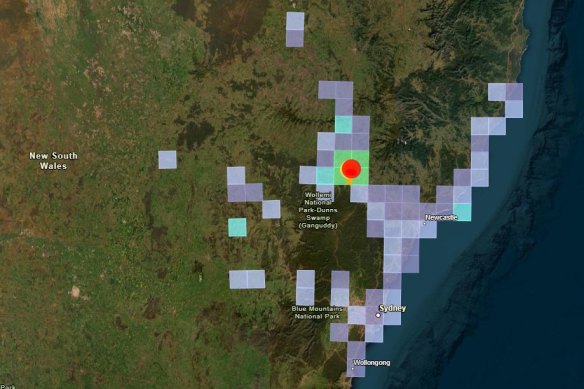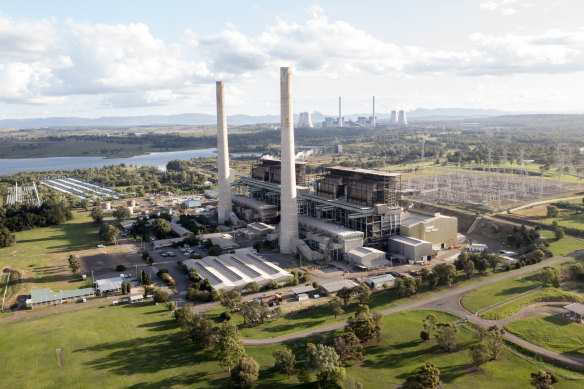Second earthquake leaves residents without power, water near site of proposed nuclear plant
By Ben Cubby, Jessica McSweeney and Michael Ruffles
An earthquake in the NSW Upper Hunter region left thousands of homes without power and water, a day after a magnitude 4.7 tremor hit the area on Friday.
Geoscience Australia reported seismic activity near Muswellbrook at 4.31pm on Saturday, recording a magnitude 4.5 quake.

The quake on Saturday afternoon was felt across the region.Credit: Geosciences Australia
About 2500 people were reportedly left without power on the south side of Muswellbrook.
“Following earthquake aftershocks, parts of Muswellbrook Shire are without water, including Woodland Ridge and potentially areas of Eastbrook Links,” the council said on its social media on Saturday afternoon.
In an update just after 6pm, it said: “Water services are now returning to normal.”

Stock on the floor of the Mitre 10 in Muswellbrook after the quake struck at 12.01pm on Friday.
The council also said there were power outages in some areas of Muswellbrook Shire, but power was expected to return in a few hours.
NSW Police said in a statement on Saturday evening that there were no reports of injury or damage to infrastructure.
The tremor came after a magnitude 4.7 earthquake struck near Muswellbrook just after noon on Friday, a few kilometres from the site where the Coalition has pledged to build a nuclear power plant, damaging some buildings in the town and sending tremors as far away as Sydney.
The State Emergency Service was called to help some people who suffered damage to their homes and businesses in Muswellbrook, but there were no reports of serious injuries.
Some buildings in Muswellbrook’s CBD had broken windows, fallen chimneys and stock spilling off shelves, locals said on Friday.
Tremors were felt in a large radius around the quake’s epicentre at Denman, just south of Muswellbrook, from southern Sydney to Coffs Harbour on the Mid North Coast.
About 2400 people contacted Geoscience Australia to report that they had felt the quake which struck at 12.01pm on Friday, senior seismologist Hadi Ghasemi said.
“That is a very large number,” he said. “The earthquake itself was of a decent size and at a depth of 10 kilometres it was quite shallow, so it’s not surprising that it was widely felt.”
Ghasemi said fault lines run near the quake’s epicentre, and these had probably been triggered by stress building up as Australia’s continental plate nudges slowly north-east at a pace of about seven centimetres per year.
The quake’s epicentre was a few kilometres west of Lake Liddell, where the federal Coalition plans to build a nuclear power plant if elected.
Nuclear facilities can be designed to withstand quakes of magnitude 4.8 and above, according to the World Nuclear Association and studies prepared by the Australian Nuclear Science and Technology Organisation for the Lucas Heights reactor in southern Sydney. However, hardening nuclear facilities against large quakes would add to the overall cost of building them.
The quake’s epicentre was also close to four large coal mines which use explosives that can cause small seismic effects. Mines have been known to trigger larger earthquakes, but Ghasemi said this was unlikely to have been the case on Friday.

The decommissioned Liddell coal-fired power station, which is slated for a nuclear reactor site under the Coalition’s plans.Credit: Janie Barrett
“It is known that mines can induce earthquakes but looking at the seismicity of the region there are natural fault lines and a history of quakes,” he said.
“My opinion is that it’s unlikely given the size and depth of this quake that it was related to mining.”
The earthquake took place about five kilometres underground - relatively shallow for a quake of that magnitude.
It was the largest earthquake to hit the region in over two decades. The Newcastle quake of 1989, which claimed 13 lives, was 5.6 magnitude and caused extensive damage in central areas of the city.
Workers at BHP’s Mount Arthur coal mine, which is directly above the epicentre, proceeded with planned mine explosions on Friday afternoon after the quake had struck.
with Michaela Whitbourn
Get alerts on significant breaking news as happens. Sign up for our Breaking News Alert.